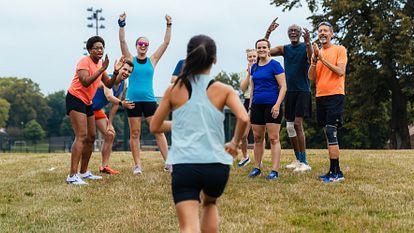4. Ignoring pain
As a runner, you learn to get comfortable with discomfort, which helps you to run longer and get faster. But there’s a big difference between pushing through fatigue and ignoring your body’s warning signals of true pain on the run. It’s tough to tell the difference at first, but over time you learn how your body feels when you need new shoes, need to do more strength work or need to take an extra rest day to recover.
In a Zoom call with Fleet Feet, professional steeplechase runner, Emma Coburn, says, “there’s a difference between aches and pains and true injury. Honestly, that’s a struggle every athlete has and I think it’s so individual. I know the trends in my body. So, if I have a sore knee for a day I’m not going to freak out because I know that means my quads are tight. I know my body well enough to say, well, that pain, that’s different and in a scary spot. You can problem solve by tracking your own patterns and trends, but also, don’t be afraid to go ask for help. Go see a PT or massage therapist who is an expert on the human body.”
Physical Therapist Miriam Salloum (also known as the Runner’s Mechanic), of Asheville, NC, recommends taking action right away if you start to feel consistent pain on the run. The sooner you address the issue, the better your chance to fix it without experiencing a full-blown injury.
Reduce your distance and intensity for a few days rather than be forced onto the sidelines for several weeks or months. Read Salloum’s recommendations here on what to do when you feel an injury coming on.
5. Not getting adequate rest
Rest and time off can be a scary concept to some runners. Running makes you feel good, so why would you want to stop doing it?
While running benefits your health in many ways, it’s also a repetitive motion that impacts your body with every step. Your bones, tissues and muscular systems need adequate sleep every night to repair and adapt to your training. The same systems also benefit from occasional days off from running.
In an interview with Fleet Feet, experienced runner and endurance running coach, Maxx Antush of Bellingham, WA, recommends scheduling regular recovery weeks in which athletes continue to run, but decrease their mileage and intensity.
“By allowing your body to adequately recover and adapt from hard training, you are able to apply more stress and ultimately stimulate more improvements down the road,” Antush says. “Taking scheduled recovery weeks has the potential to avoid musculoskeletal injuries before they ever occur and allows your body the chance to absorb the training that you have been doing.”
There are many ways to approach recovery, and the “best” option depends on the individual, their training and their experience level. Some runners like to take at least one day off per week. Others will take weeks to a month off after a long training cycle. Some will supplement running with cross training, like swimming or biking. No matter what you choose, be mindful of the way your body feels. If you feel constantly tired, it may be time to take a break.









Join our Newsletter
Get deals, events, and more.
Connect with Fleet Feet
Get involved on social media.
Find a Location
Fleet Feet has over 250 locations nationwide!
Find a Store